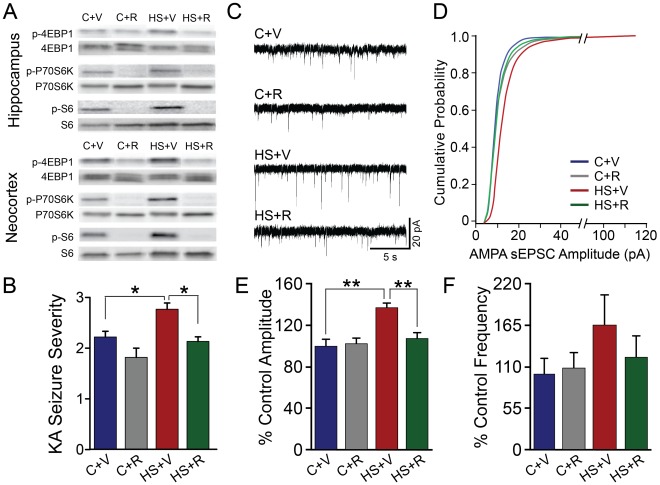Figure 6. Rapamycin attenuates seizure-induced mTORC1 pathway activation, subsequent subacute increases in seizure susceptibility, and enhanced AMPA receptor function.
A. Representative western blots of hippocampal and neocortical tissue, collected at 12–24 h post-HS, show that rapamycin treatment almost completely blocks phospho-4EBP1, phospho-p70S6K and phospho-S6 in HS and normoxic control animals, with no effect on total protein levels. The rapamycin-treated HS rats (HS+R) demonstrate a significant reduction of phospho-4EBP1/4EBP1 (0.48±0.07, n = 8, p<0.05 in hippocampus, and 0.52±0.04, n = 8, p<0.01 in neocortex), phospho-p70S6K/p70S6K (0.43±0.04, n = 4, p<0.05 in hippocampus, and 0.19±0.06, n = 8, p<0.001 in neocortex), and phospho-S6/S6 (0.03±0.02, n = 4, p<0.001 in hippocampus, and 0.08±0.02, n = 4, p<0.001 in neocortex), relative to vehicle-treated controls (C+V) (1). Sham control rats treated with rapamycin (C+R) also show a significant decrease in phospho-4EBP1/4EBP1 (0.56±0.06, n = 8, p<0.05 in hippocampus, and 0.53±0.04, n = 8, p<0.01 in neocortex), phospho-p70S6K/p70S6K (0.45±0.05, n = 4, p<0.05 in hippocampus, and 0.16±0.01, n = 8, p<0.001 in neocortex), and phospho-S6/S6 (0.1±0.02, n = 4, p<0.001 in hippocampus, and 0.08±0.03, n = 4, p<0.001 in neocortex), compared to vehicle-treated sham controls (C+V). B. Rapamycin treatment reduces subacute increases in seizure susceptibility induced by kainic acid (KA) administration. When exposed to KA at P13, vehicle-treated HS rats (HS+V) demonstrate a significant increase in the average seizure severity (2.8±0.12, n = 13; modified Racine scale, see methods), compared to vehicle-treated normoxic control littermates (C+V), (2.2±0.11, n = 27, p<0.05). Rapamycin-treated HS rats (HS+R) show a significant decrease in KA seizure severity, relative to the HS+V group (2.13±0.09, n = 15; p<0.01). C. Representative traces of AMPA receptor-mediated spontaneous excitatory post-synaptic currents (sEPSCs), pharmacologically isolated by blocking NMDA and GABAA receptors, in hippocampal ex vivo slices from control and HS rats treated in vivo with either vehicle (C+V, HS+V) or rapamycin (C+R, HS+R) and removed at 48 h post-HS (P12). D. Normalized cumulative distribution of AMPA receptor sEPSCs, recorded at 48 h post-HS demonstrates a significant increase in amplitude in the vehicle-treated HS (HS+V) animals compared to vehicle (C+V) or rapamycin-treated controls (C+R), and this is significantly attenuated by in vivo rapamycin treatment (HS+R), (p<0.001, Kolmogorov–Smirnov test). E. AMPA receptor sEPSCs amplitude is significantly higher in the vehicle-treated HS group (HS+V), relative to vehicle-treated controls (C+V), (137.62±3.39% of vehicle-treated controls, n = 6; p<0.001), and reduced significantly in the rapamycin-treated HS rat pups (HS+R), (107.93±4.64% of vehicle-treated controls, n = 6; p<0.01). In vivo rapamycin treatment has no effect on AMPA receptor sEPSCs amplitude in the normoxic control rats (C+R), (102.28±5.4% of vehicle-treated controls; n = 6, p>0.05). F. AMPA receptor sEPSCs show a trend of increased frequency in the HS+V group, compared to C+V and C+R groups (164.98±37.98% of vehicle-treated controls, n = 6, p = 0.16), which is attenuated by in vivo rapamycin treatment (122.35±26.5% of vehicle-treated controls, n = 6). In vivo rapamycin treatment has no effect on AMPA receptor sEPSCs frequency in the normoxic control rats (C+R) (108.39±18.6% of vehicle-treated controls, n = 6, p>0.05). *: p<0.05; **: p<0.01. Error bars indicate S.E.M.

